During the summer, Red Bull Salzburg experienced great shocks as head coach, Jesse Marsch, departed along with several key players such as Patson Daka, Enock Mwepu, and André Ramalho. However, under the leadership of Matthias Jaissle, they achieved a historical breakthrough by entering the last-16 of the UEFA Champions League. One of the players stepping up to fill the positions of those who departed is Brenden Aaronson.
Interestingly, many teams in the major leagues already wanted Aaronson on their team. Marcelo Bielsa’s Leeds United was one of them, and now with Marsch becoming the new Leeds head coach, the rumours linking Aaronson with this English club have continued. We believed it was Aaronson’s playing style that was very attractive to Leeds. With some talents, such as Karim Adeyemi, Vinícius Júnior, and Darwin Núñez, you clearly spot their good quality on the ball. However, Aaronson is a bit different, instead of scoring goals and assisting, so far, the most valuable trait of this player has been his pressing — that’s why Leeds are said to be crazy about him.
This scout report is a tactical analysis that details Aaronson’s profile and explains why he is one of the best talents in the world in terms of pressing.
Data analysis
Firstly, we’ll look at Aaronson’s numbers to develop an early picture of the player.
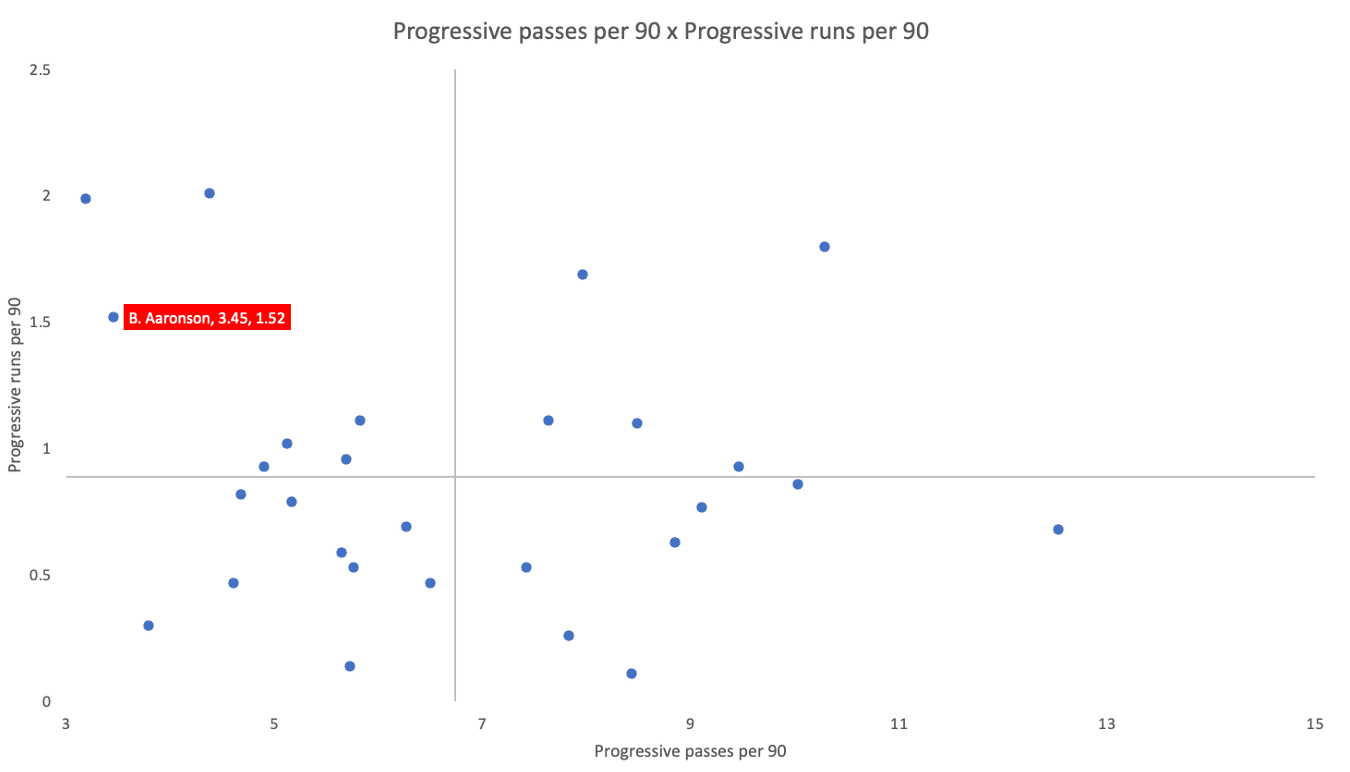
Firstly, we looked at the progressive stats of Austrian Bundesliga midfielders to evaluate where Aaronson falls — and he was not good in either metric. Instead, in terms of progressive passes per 90, he was lower than many players at 3.45 progressive passes per 90, but that was conceivable given he has played as a 10 who operated closer to the penalty zone rather than receiving deep. However, you could also spot his significance in his ball-carrying, as his 1.52 progressive runs per 90 ranked fifth; this was his way to advance the attack for the team.
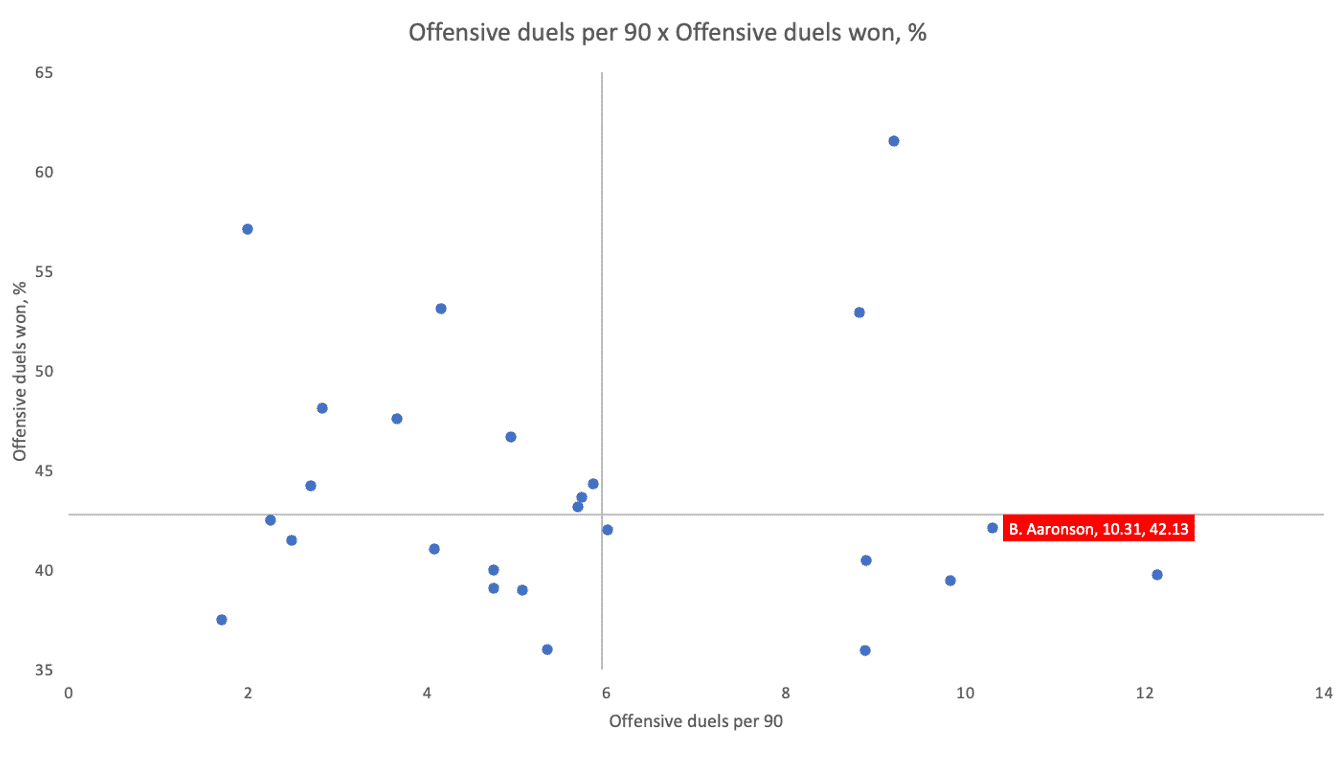
Apart from progressive runs, we could also see offensive duels as an indicator of his on-the-ball ability. Perhaps slightly surprising, Aaronson makes a lot of offensive duels per 90, the figure is 10.31, but the success rate is not impressive, his 42.13% success rate was not even reaching the mean of all Austrian Bundesliga midfielders. So, in these 1v1 offensive challenges, Aaronson definitely had room for improvements in this regard.
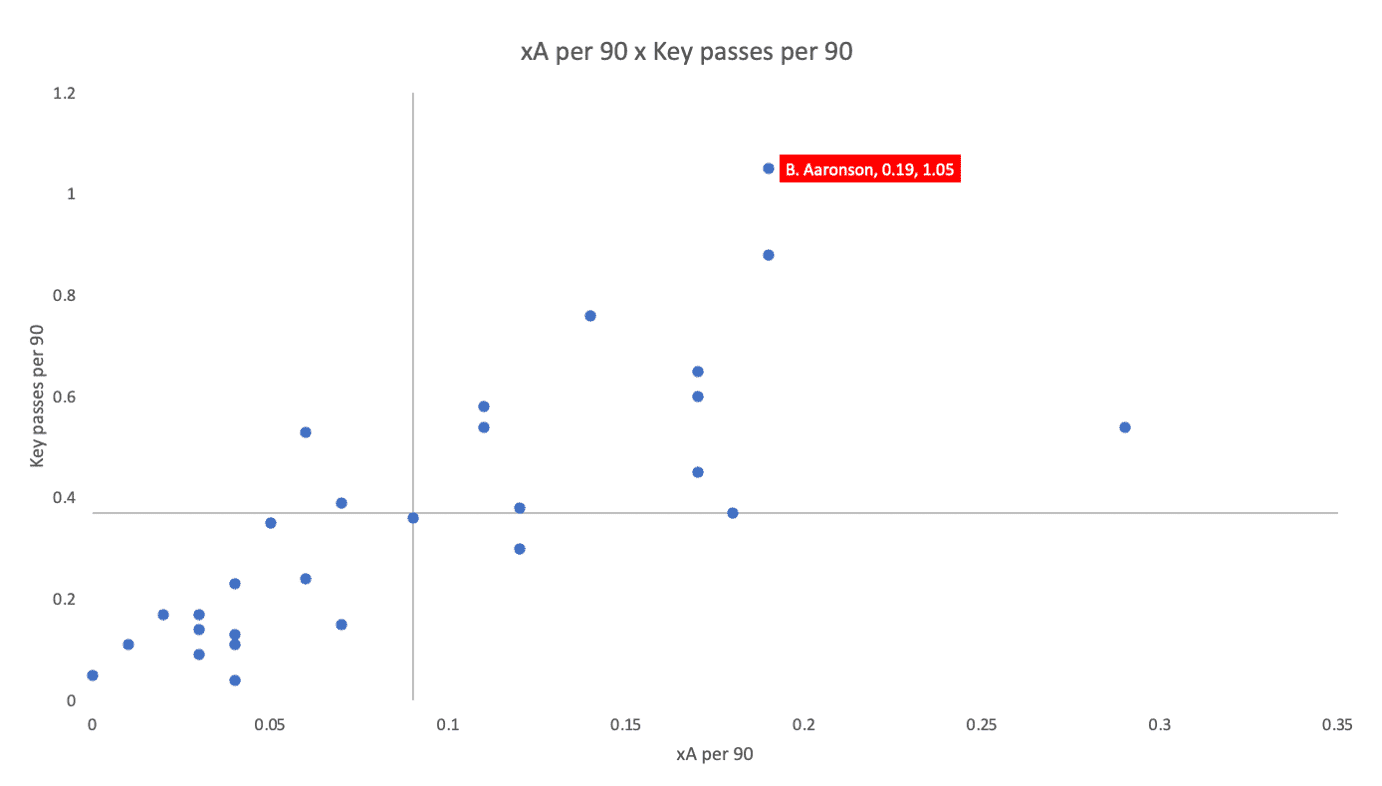
He shows some goal-threat in the final third, including creating chances for teammates. In this scatter plot, we show the xA per 90 and key passes per 90 of Austrian Bundesliga midfielders. Aaronson’s 0.19 xA per 90 ranks second in the league, while 1.05 key passes per 90 is far higher than any other midfielder, while he’s the only one who recorded several>1 in this metric.
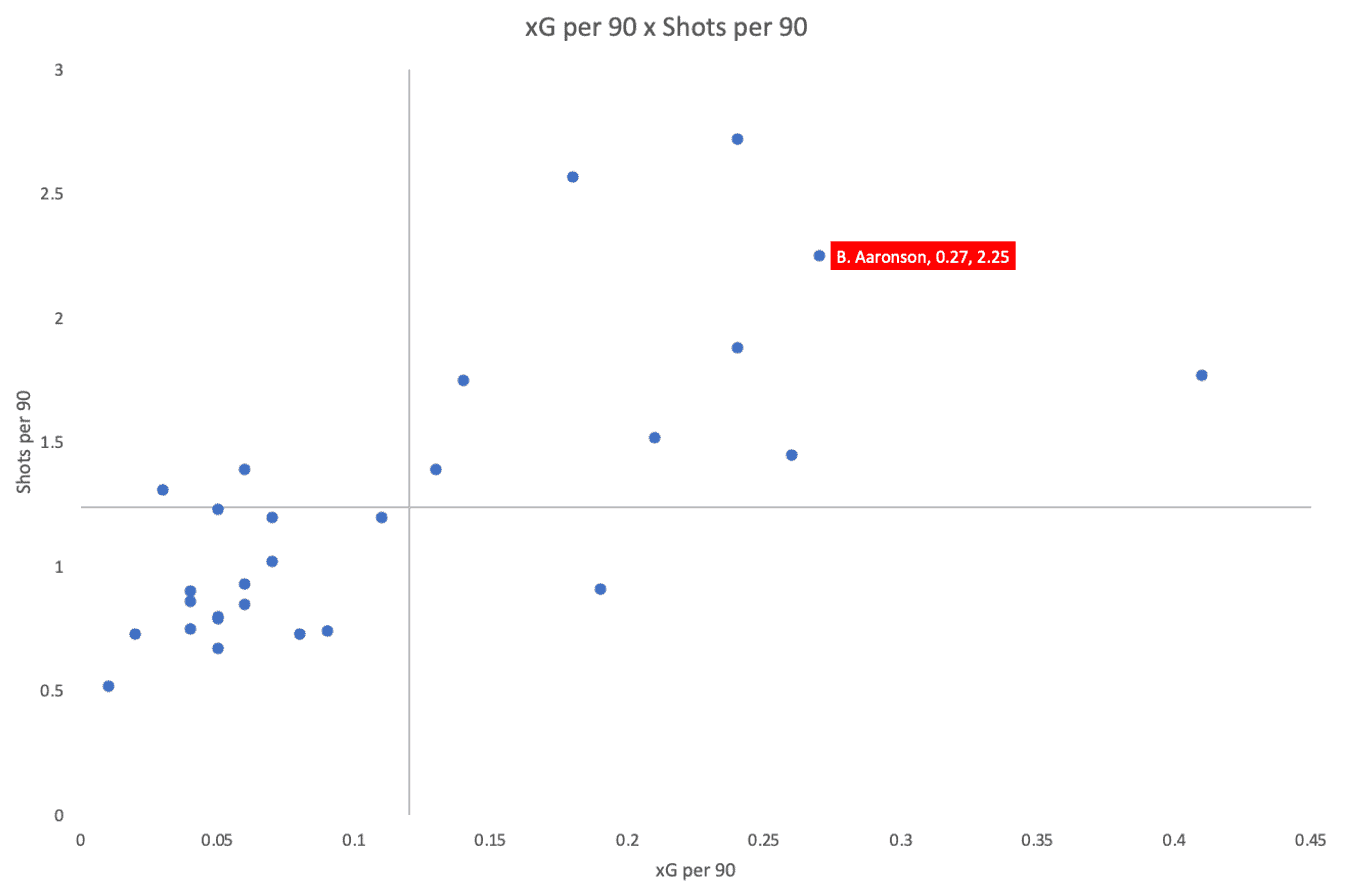
In terms of xG per 90, Aaronson was quite good as his 0.27 xG per 90 is also the second in the league and his shots per 90 at 2.25 is high as well, ranking third. His frequency of testing the goalkeeper is high and the shots are no-nonsense —his goal threat is indicated by the numbers.
Intelligence in the press
Apart from the stats in the previous section, according to FBref.com, Aaronson makes 27.1 pressures per 90, with a percentile rank of 99, which means he performs stronger than almost all players in Europe in this regard, which might not be surprising given he’s playing for Salzburg. However, pressing is not only about running around to chase after the ball, but it is also a matter of technique and decisions in the elite level of football, and Aaronson possesses all these qualities.
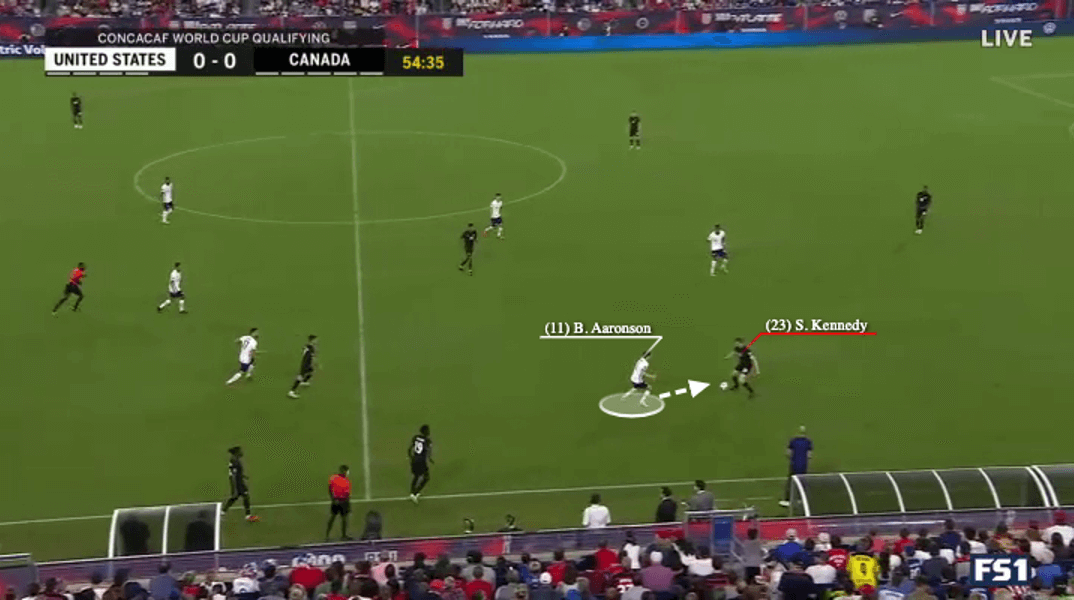
Another strength of Aaronson’s is his pressing intensity. In this World Cup qualifier, the opener he scored can be attributed to his good pressing. We can see in the first image, Aaronson was approaching Scott Kennedy after the opponent threw the ball at him. The control was not good because the ball was too close to his feet, hence, Aaronson’s run was not at max speed, or else he would just run past the opponent and Kennedy could move the ball to spaces on either side.
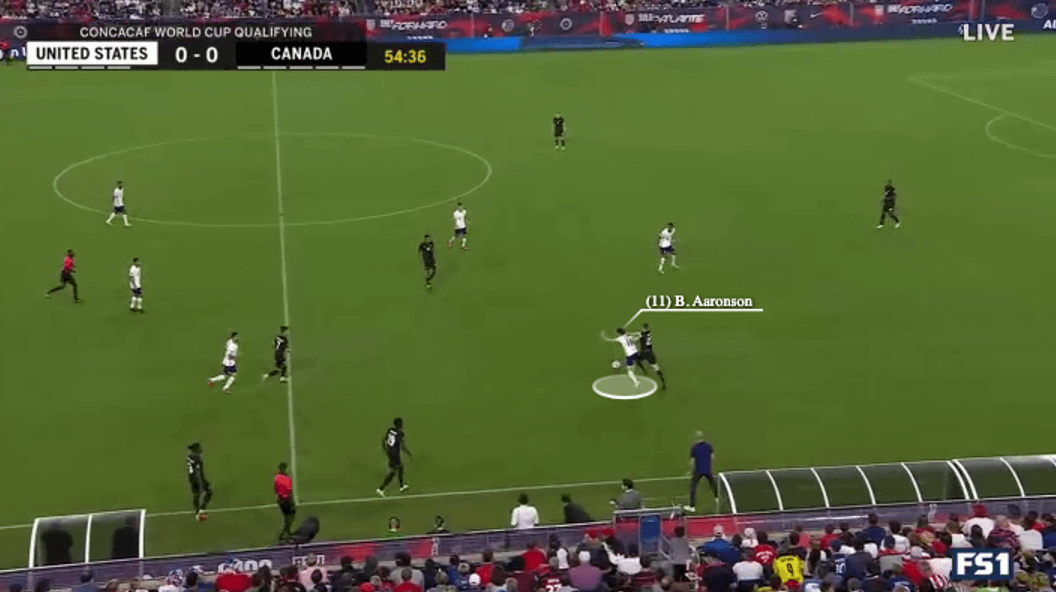
Since Aaronson did not rush in at max speed and run past the opponent when Kennedy tried to shift the ball to the inside, it was easily read by Aaronson and there was distance and time for a change of direction. Then, as shown in the next image, he already got control of the ball, with Kennedy behind him.
As shown in this example, in terms of defensive technique, Aaronson is very good at using his body to separate the ball from the opponent. This is useful in both offensive and defensive situations, with this example from the Canada game showing an example of his good use of body strength defensively.
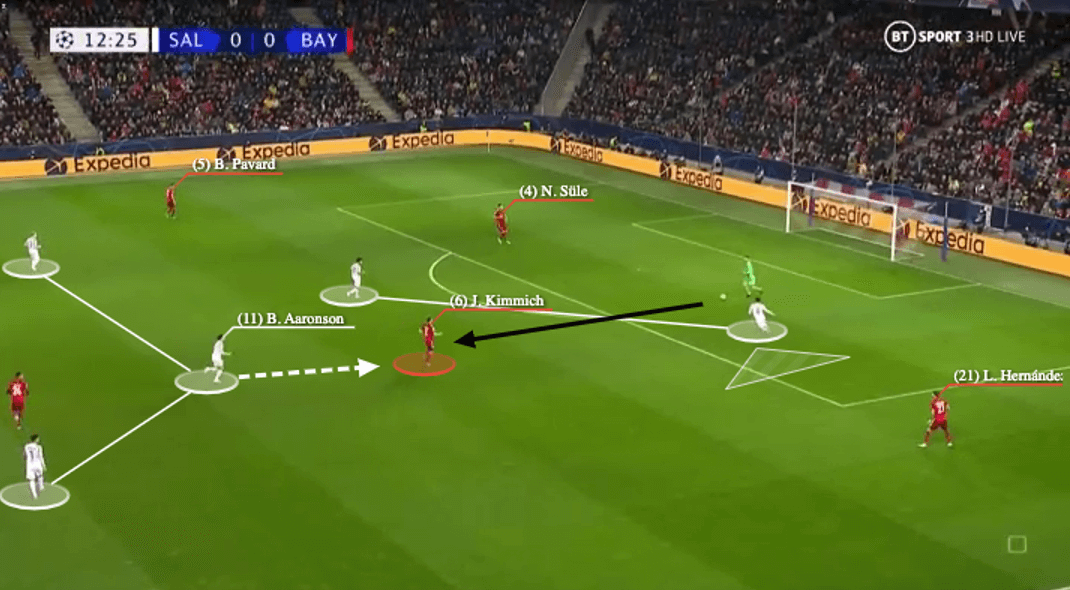
Aaronson’s decisions when pressing are excellent. The previous example was more about individual defending and the technique. On the other hand, in this situation against Bayern, Aaronson’s good pressing demonstrated important tactical values to the side.
As usual, Salzburg were pressing in a 4-Diamond-2 shape, Aaronson’s role was very simple, closing the opponent 6, especially if that was Joshua Kimmich because he was good on the ball. On this occasion, the striker pressed from the outside to close the keeper’s angle to Lucas Hernández, but that also means he showed the inside to allow Sven Ulreich to find Kimmich. This was a situation in which Aaronson was called into action, and he jumped out to press.
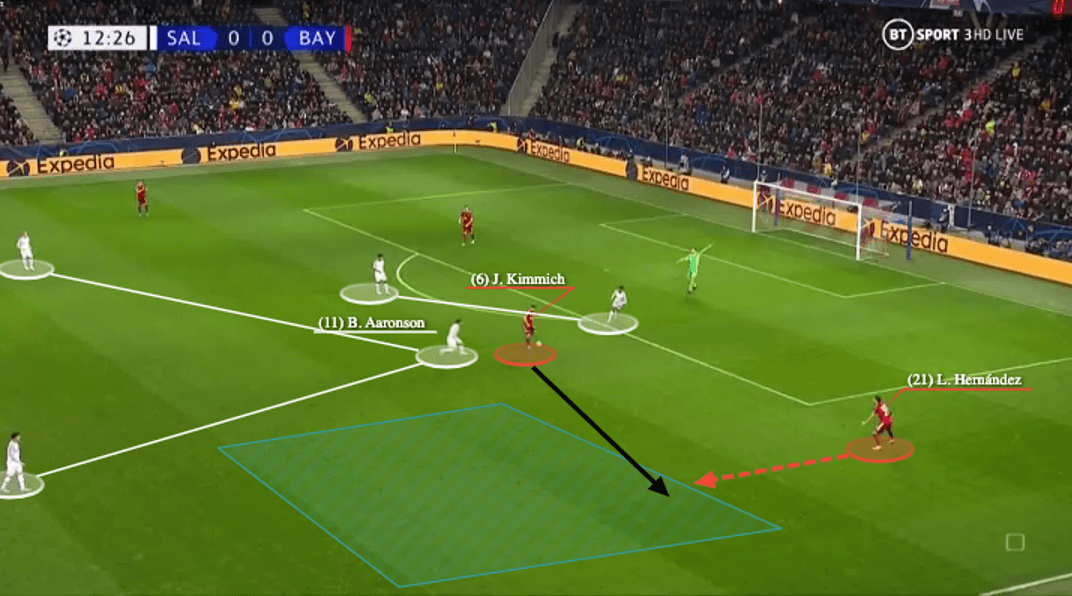
But it was tricky since Aaronson arrived from a greater distance, this meant he could not access the opponent on time. So, when Kimmich had the ball at his feet, Aaronson was yet to reach the target, now it showed his quick change of decisions and adaptations to the circumstance. He stopped because he knew Kimmich would not turn or try to dribble in such a case, attacking him was not the best option because the solution was clearly a pass.
Tactically, Bayern’s 3-2 shape helps them to vacate the half-spaces against the two-man first line of Salzburg, so Hernández was able to access the free spaces in the build-up as indicated here. It was impressive to see Aaronson notice that little dynamic in the game.
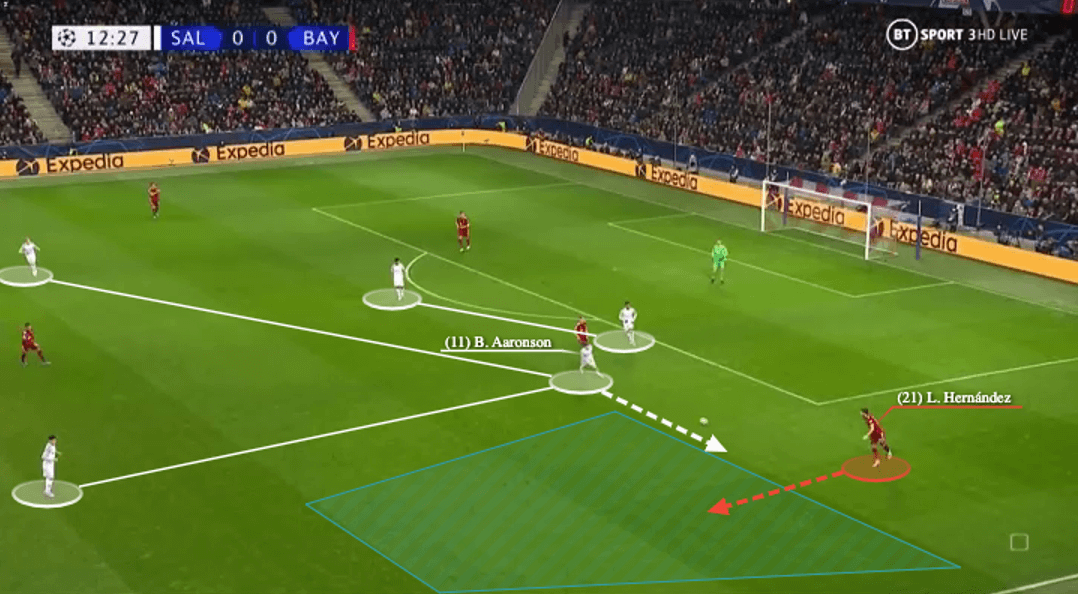
The reason for slowing down a bit when approaching Kimmich, and bait the pass to outside, was to allow Aaronson to have another chance to re-press on the outside. If the American just ran one way at full speed, he would be more likely to run beyond Kimmich and position himself behind the ball when Hernández received. Now, because of the pause, it was much better as they were at least in the parallel zone, and Aaronson could go back and chase the receiver. He eventually won the ball back close to the attacking third as well thanks to the good defending technique we highlighted at the beginning.
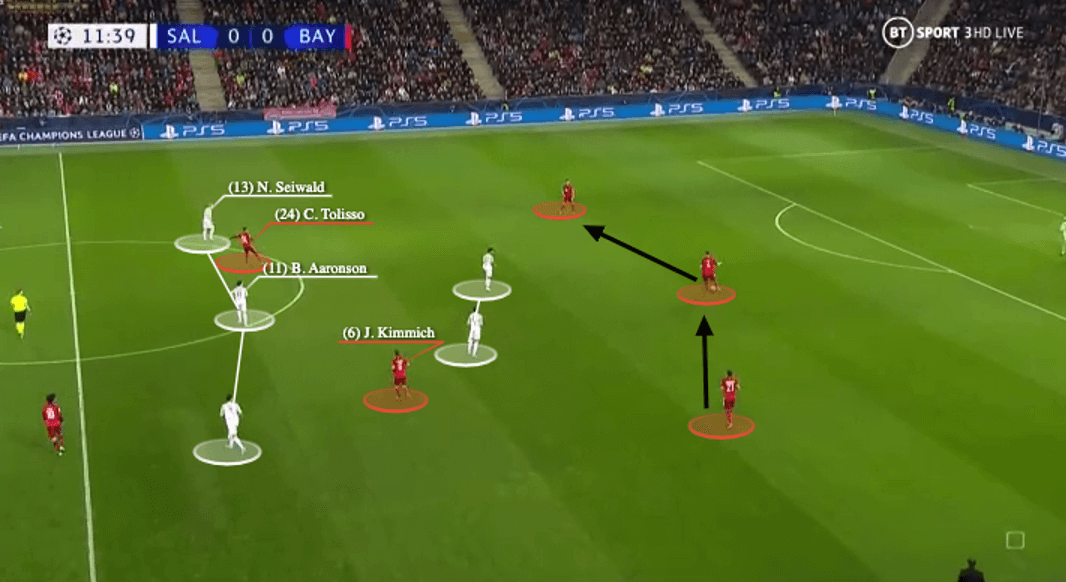
Of course, even though Aaronson is a 10, it is not only about pressing all the time. Sometimes, the tactics of the team needs more balance, and “cover” is also an important concept in such a case. The tactical understanding of this player without the ball is often of the highest standard, as shown in this battle against Bayern.
The Bundesliga champion continued using a 3-2 shape in the construction, circulating the ball from side to side through the centre-backs. The tricky point of this shape was the double-6, and as Salzburg only had one 10, man-marking was impossible, meaning Aaronson must be able to choose to cover one of them intelligently.
When Bayern were moving the ball, Aaronson reacted very well by abandoning Kimmich and moving closer to Corentin Tolisso, because the Salzburg 8 would jump or orient himself to the wide space, as a result, Tolisso might be unmarked.
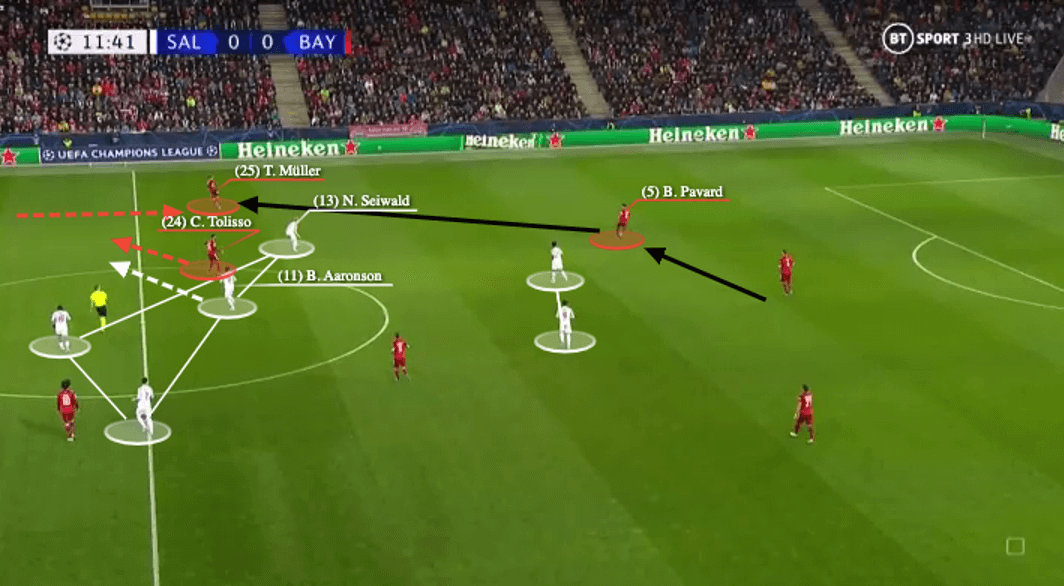
Bayern were also a clever side, as the pass from Niklas Süle to Benjamin Pavard did not attract the Nicolas Seiwald press, the Salzburg 8 was a bit conservative and held his ground in such a case. However, there was another problem when Thomas Müller dropped outside to receive, that took Seiwald’s attention as the Bayern wing-back was high to pin Salzburg’s full-back and there was no spare man to deal with Müller.
Meanwhile, Tolisso made a diagonal forward run to access spaces behind Seiwald.
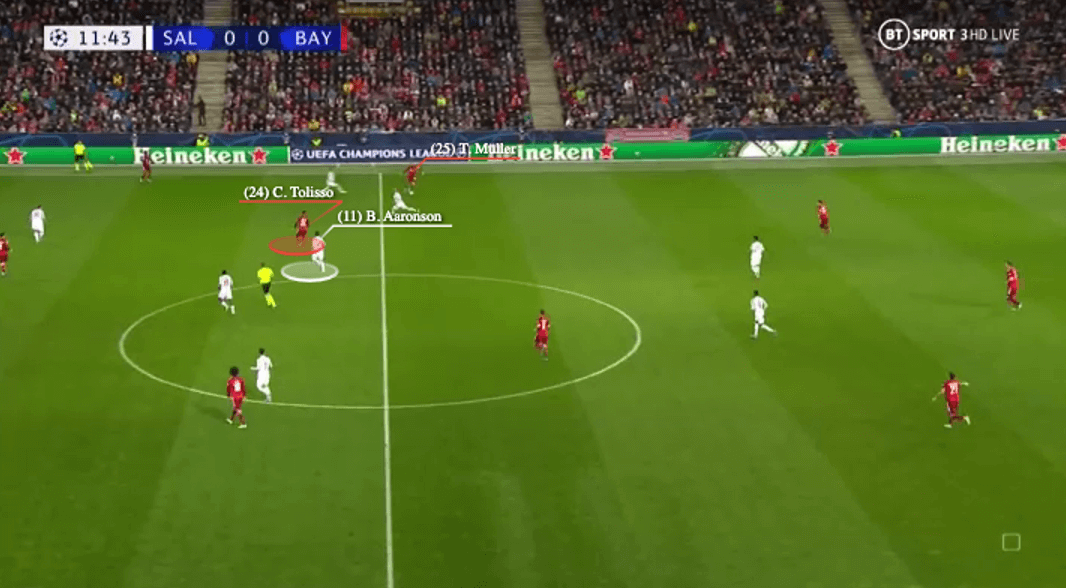
Eventually, this image shows the importance of Aaronson’s defensive work. When Müller received, Tolisso would be free to receive in the half-spaces if no one tracked him. Aaronson could have easily stayed with Kimmich because that was also a Bayern 6. Instead, he showed a good mindset and defensive awareness to cover the ball-side 6, which lowered the interests of Müller forcing the ball to progress the attack. Even though this tracking did not result in ball recovery, Aaronson’s effort should also be highly appreciated as it denied the ball progression.
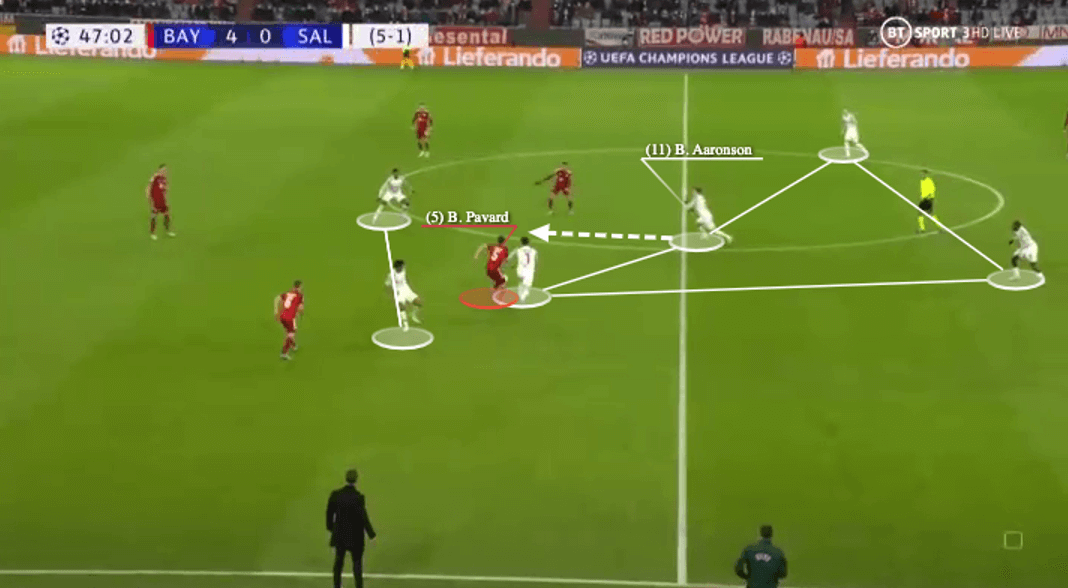
In addition, Aaronson also showed the ability to anticipate an attack, which is not only useful when Salzburg are in possession but also when without possession, as he could use this skillset to intercept when he sees the passes early, so actions are then taken earlier as well.
Here, Salzburg forced Pavard to dribble inside, and Aaronson, who was a bit deep initially, spots the lateral pass going inside. He did not hesitate when required to jump out to press and the ball was won back in the centre.
Again, his close control of pace and acceleration over short distances is very useful in the execution. That was the fundamental of Aarsonson’s pressing and defending.
In possession and TDA
After explaining how Aaronson contributes to his side in the press, since he has good spatial awareness and a certain level of technique, he is also able to provide a lot in the attack. The first example is taken from Salzburg’s only goal at the Allianz Arena, except for the tactical aspect, we could also examine the good mentality of the young USA international. The game was dead at this point, with Bayern leading 5-0, so the players could have given up, taken it easy and slowed down, but Aaronson showed a strong mentality to fight — a mentality that will be important to carry forward in his career.
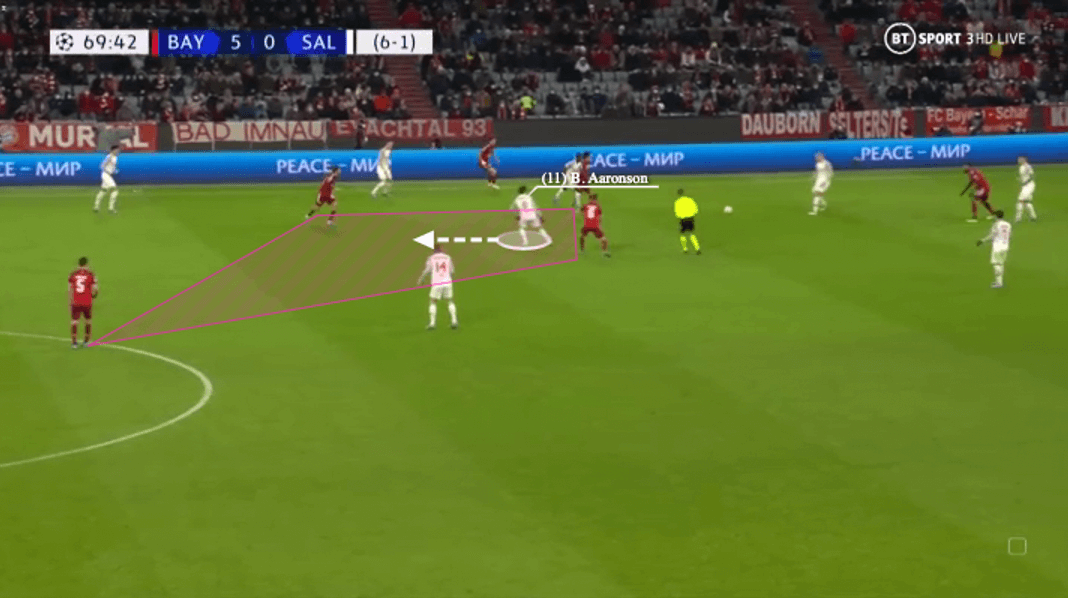
Aaronson was significant to the goal, as Salzburg regained possession. In TDA, he was not dropping to receive the ball to feet. Since Aaronson had a good spatial perception, he knew where the space was and always showed the desire to access it. On this occasion, he drifted into space between Bayern’s first and second rest defence lines, but the ball did not come vertically towards him, as the retriever decided to go outside first.
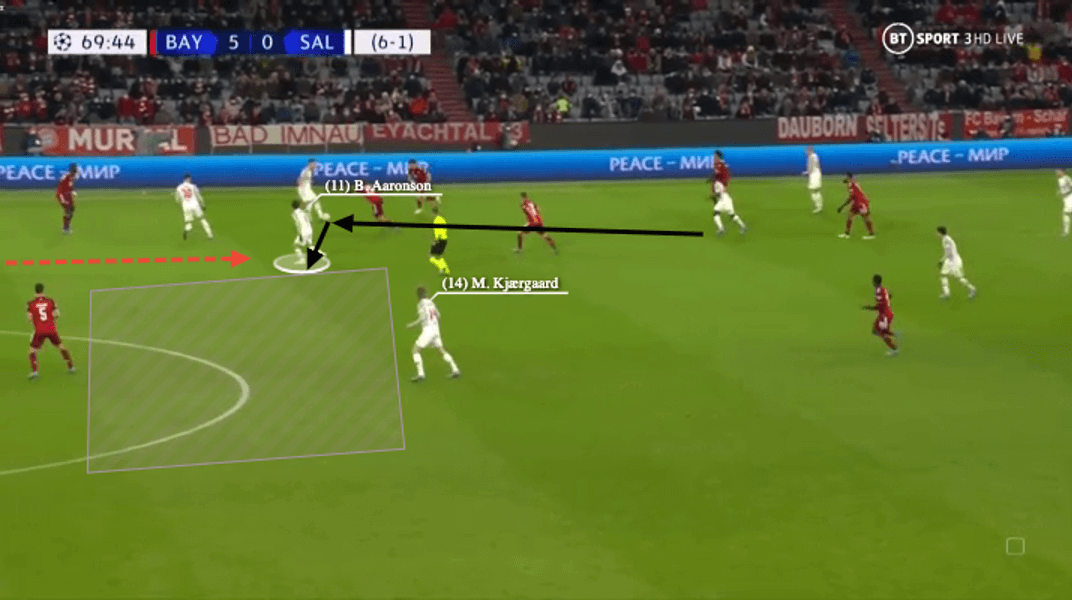
Therefore, Aaronson’s role in this attack was more like a third man in the centre, because now the ball would be coming in from the outside. Note the good adjustment of body shape in the process, as Aaronson now faced the opposition, which was better than facing the touchline in the initial incident. This helped him to spot the direction of the centre-back’s pressing, and allowed him to access the purple zone in the centre. If he put his back to the purple zone, it would be more difficult to use that space when the ball came as the turn required a larger angle.
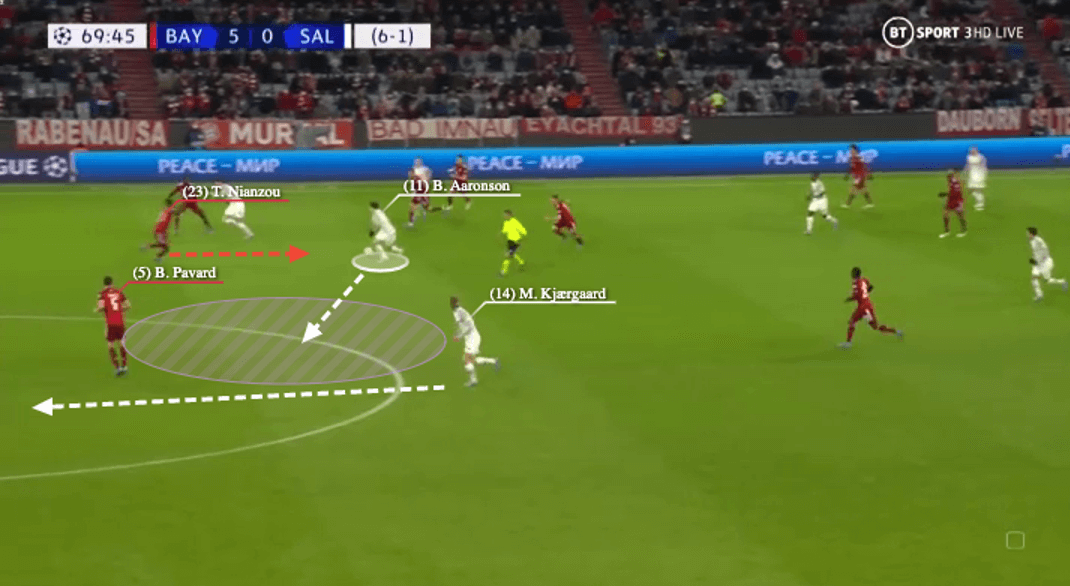
Since the preparation work was very good, Aaronson was able to see things early and use different tools from his arsenal to adapt. He knew Tanguy Nianzou was pressing from a vertical angle, and because his body orientation was opened, with just one simple no-touch turn, he let the ball roll into the purple zone and escaped from the challenge.
On this occasion, Pavard could not press as Maurits Kjærgaard was also pushing, but that delaying of defensive engagement did not help Bayern stop the counter-attack that Aaronson was behind.
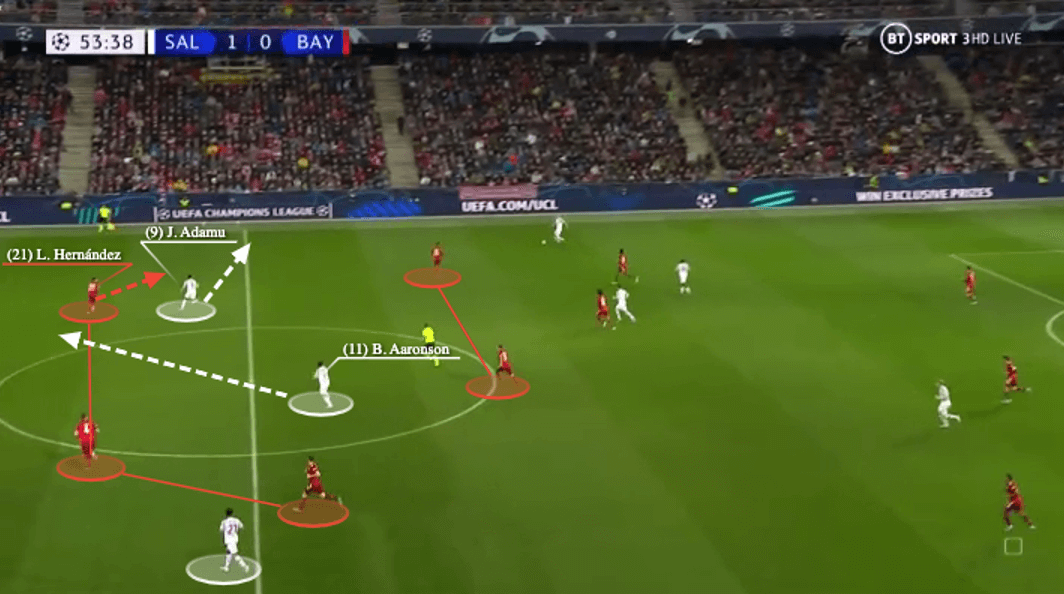
As a 10, Aaronson has shown good tactical understanding to support the striker or find spaces. Sometimes, he is required to push and search for the attacking depth because the last line is stretched. On other occasions, he can play in spaces (the RED ZONE) since the centre-backs are occupied by the strikers.
On this occasion, Junior Adamu’s movement to the outside dragged Hernández away, and there was a visible gap between the centre-backs for Aaronson, who was in the red zone initially, to spot and move early. He could not move too late here since he did not possess the raw pace to beat the defenders.
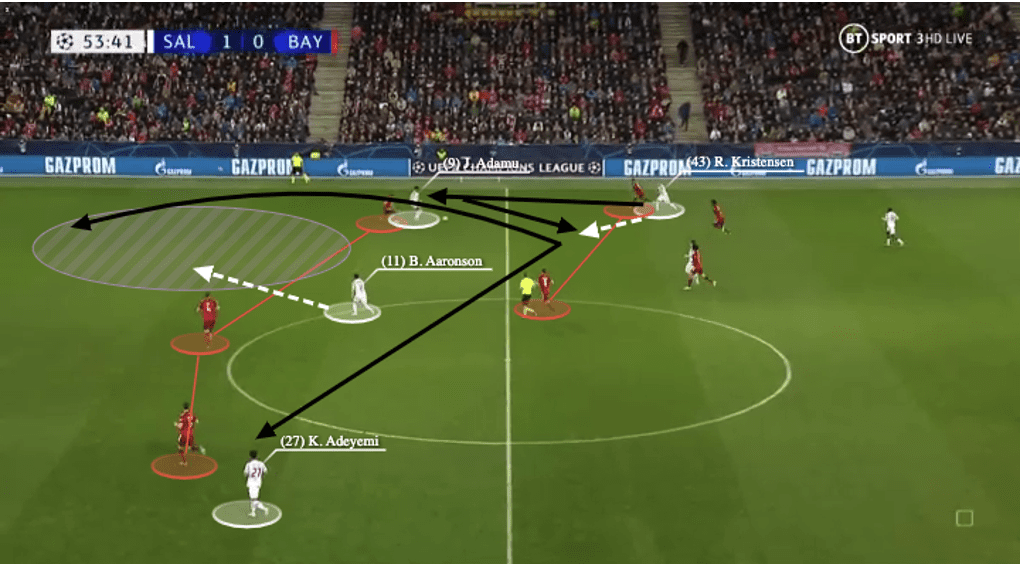
Since Aaronson moved in advance, he created a very good condition in case Rasmus Kristensen received the lay-off from Adamu. Süle was forced to react to Aaronson’s move, and Kristensen could hit a pass into the space behind Hernández provided no one tracked Aaronson. At the same time, if Süle tracked Aaronson, there was another problem for Bayern, as now Pavard would be isolated against Adeyemi, who also possesses good qualities on the ball. This is a good example of how Aaronson is able to create dynamics with his off-the-ball movements.
Conclusion
As we have shown in this analysis, Aaronson is a very special player. He has a good perception of space and that helps him to evaluate the situations with and without the ball, that’s why he can thrive as a 10 under Jaissle at Salzburg. Moreover, he also shows potential to play as either an 8 or a winger in other systems. He is still young, and that versatility will help him to get more opportunities in the future. Of course, we also point out that Aaronson can further improve his technique on the ball, but provided he carries his impressive mindset forward, the sky is the limit for him as he accumulates more minutes on the pitch.

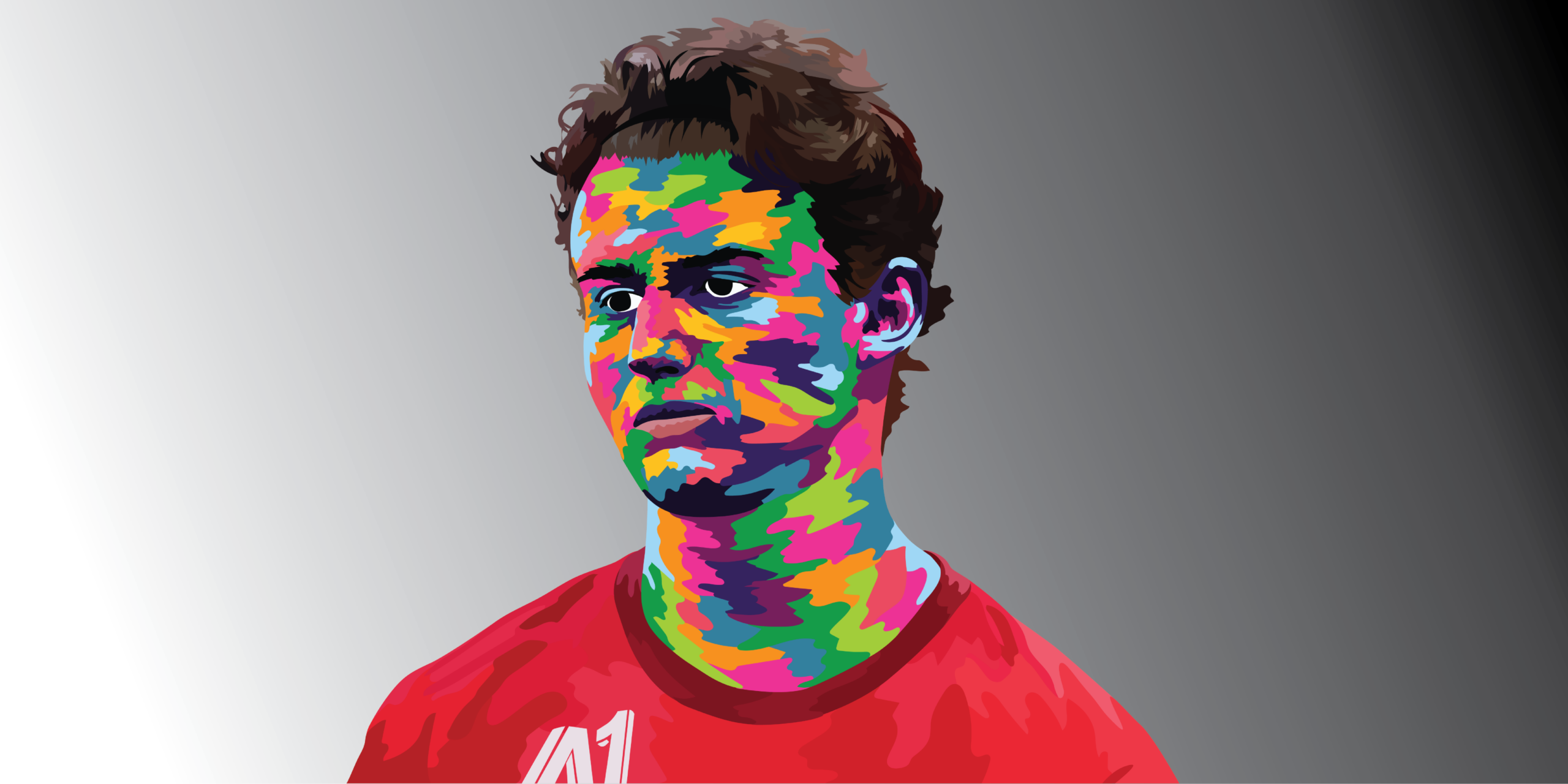



Comments